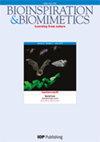仓鸮前缘锯齿与自由流湍流的相互作用
IF 3.1
3区 计算机科学
Q1 ENGINEERING, MULTIDISCIPLINARY
引用次数: 0
摘要
谷仓鸮的无声飞行与翅膀和羽毛的特化有关。谷仓鸮有三个已知的特殊特征:由独立倒钩尖端形成的锯齿状前缘(呈现梳状结构)、柔软的背表面和带流苏的后缘。我们使用了一个具有三维弧形锯齿的前缘梳子模型,该模型是根据对所选乌鸡羽毛上的倒钩行进行三维微型扫描而设计的。我们使用粒子图像测速仪测量了流道中均匀稳定流入的水流与锯齿的相互作用,并将其与自由流湍流的流入情况进行了比较,自由流湍流是由放置在上游的圆柱体的湍流尾流产生的。在稳定的匀速流中,锯齿造成了规则的速度条纹和流动转向效应。当不同大小的涡流撞击锯齿时,锯齿在每种情况下都会减弱下游的流动波动,例如锯齿尾流波动的均方根值减小。这种衰减效应对跨向速度分量的影响更大,从而导致整体流动均匀化。我们的研究结果表明,仓鸮的锯齿提供了一种被动的流动控制,从而降低了在湍流环境中飞行时的前缘噪声。本文章由计算机程序翻译,如有差异,请以英文原文为准。
Interaction of barn owl leading edge serrations with freestream turbulence
The silent flight of barn owls is associated with wing and feather specialisations. Three special features are known: a serrated leading edge that is formed by free-standing barb tips which appears as a comb-like structure, a soft dorsal surface, and a fringed trailing edge. We used a model of the leading edge comb with 3D-curved serrations that was designed based on 3D micro-scans of rows of barbs from selected barn-owl feathers. The interaction of the flow with the serrations was measured with Particle-Image-Velocimetry in a flow channel at uniform steady inflow and was compared to the situation of inflow with freestream turbulence, generated from the turbulent wake of a cylinder placed upstream. In steady uniform flow, the serrations caused regular velocity streaks and a flow turning effect. When vortices of different size impacted the serrations, the serrations reduced the flow fluctuations downstream in each case, exemplified by a decreased root-mean-square value of the fluctuations in the wake of the serrations. This attenuation effect was stronger for the spanwise velocity component, leading to an overall flow homogenization. Our findings suggest that the serrations of the barn owl provide a passive flow control leading to reduced leading-edge noise when flying in turbulent environments.
求助全文
通过发布文献求助,成功后即可免费获取论文全文。
去求助
来源期刊

Bioinspiration & Biomimetics
工程技术-材料科学:生物材料
CiteScore
5.90
自引率
14.70%
发文量
132
审稿时长
3 months
期刊介绍:
Bioinspiration & Biomimetics publishes research involving the study and distillation of principles and functions found in biological systems that have been developed through evolution, and application of this knowledge to produce novel and exciting basic technologies and new approaches to solving scientific problems. It provides a forum for interdisciplinary research which acts as a pipeline, facilitating the two-way flow of ideas and understanding between the extensive bodies of knowledge of the different disciplines. It has two principal aims: to draw on biology to enrich engineering and to draw from engineering to enrich biology.
The journal aims to include input from across all intersecting areas of both fields. In biology, this would include work in all fields from physiology to ecology, with either zoological or botanical focus. In engineering, this would include both design and practical application of biomimetic or bioinspired devices and systems. Typical areas of interest include:
Systems, designs and structure
Communication and navigation
Cooperative behaviour
Self-organizing biological systems
Self-healing and self-assembly
Aerial locomotion and aerospace applications of biomimetics
Biomorphic surface and subsurface systems
Marine dynamics: swimming and underwater dynamics
Applications of novel materials
Biomechanics; including movement, locomotion, fluidics
Cellular behaviour
Sensors and senses
Biomimetic or bioinformed approaches to geological exploration.
 求助内容:
求助内容: 应助结果提醒方式:
应助结果提醒方式:


